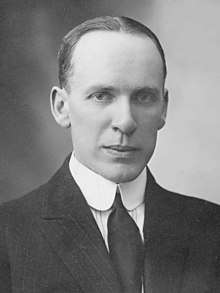Birger Nerman
Birger Nerman (6 October 1888 – 22 August 1971) was a Swedish archaeologist, professor, and author.
Birger Nerman | |
|---|---|
 | |
| Born | 6 October 1888 |
| Died | 22 August 1971 (aged 82) |
Background
Birger Nerman belonged to a bourgeois family Nerman (Nehrman) from Vimmerby. He was the son of Janne Nerman (1844–1920), the bookseller in Norrköping, and his wife Anna Ida Nordberg. Born in Norrköping, Birger was the younger brother of the Swedish Communist leader Ture Nerman and the twin brother of the artist Einar Nerman.
Career
Birger Nerman taught as a temporary professor at Uppsala University in 1917 and in 1920. In 1923 he became professor in archeology at the University of Dorpat (Tartu, Estonia). There he led the excavations of Izborsk (1924) and Grobin in Latvia (1929), among other early medieval sites.
In 1925 the Swedish Armed Forces published his The Rise of the Swedish Realm (Det svenska rikets uppkomst) in which Nerman argued that the formation of the Swedish state had been completed by the 8th century, that it was the direct continuation of the "powerful Svea kingdom" mentioned by Tacitus, and that Sweden with its history of two millennia held senior rank among the existing nations of Europe.[1]
In 1938, Nerman became the head of the Swedish Museum of National Antiquities, a position he held until 1969. In 1946, he became a member of the Swedish Royal Academy of Letters. Between 1967 and 1970, he was chairman of the Swedish Chamber of the World Anti-Communist League.[2]
Selected works
- Nerman, Birger (1969). Die Vendelzeit Gotlands (II): Tafeln. Monographien Herausgegehen von der Kungliga Vitterhets Historie och Antikvitets Akademien. 48. Stockholm: Almqvist & Wiksell.CS1 maint: ref=harv (link)
- Nerman, Birger (1975). Die Vendelzeit Gotlands (I:1): Text. Monographien Herausgegehen von der Kungliga Vitterhets Historie och Antikvitets Akademien. 55. Stockholm: Almqvist & Wiksell. ISBN 91-7402-016-1.CS1 maint: ref=harv (link)
- Grobin-Seeburg; Ausgrabungen und Funde xii, 200 pages illustrations, 61 plates, maps. Stockholm, Almqvist & Wiksell (1958) OCLC 18565106
- Nerman, Birger (1953). "Ett hjälmfragment, sannolikt från mellersta Sverige" (PDF). Fornvännen (in Swedish). 48: 123–124. ISSN 0015-7813.CS1 maint: ref=harv (link)

- Nerman, Birger (1948). "Sutton Hoo – en svensk kunga- eller hövdinggrav?" (PDF). Fornvännen (in Swedish). 48 (3): 65–93. ISSN 0015-7813.CS1 maint: ref=harv (link)

- Tiotusen àr i Sverige (1945)
- Gamla Upsala : Svearikets hjärtpunkt (1943)
- Die Völkerwanderungszeit Gotlands (1935)
- Nerman, Birger (1932). "The Grobin Finds' Evidence of the First Incorporation of Gotland Under the Svea Kingdom". Acta Archaeologica. III: 157–167. ISSN 0065-101X.CS1 maint: ref=harv (link)
- Die verbindungen zwischen Skandinavien und dem Ostbaltikum in der jüngeren eisenzeit (1929)
- Die Herkunft und die frühesten Auswanderungen der Germanen (1924)
- Studier över Svärges hedna litteratur (1913)
References
- Citat ur Det svenska rikets uppkomst (1925)
- Svenskt biografiskt lexikon (Stockholm. 1988)